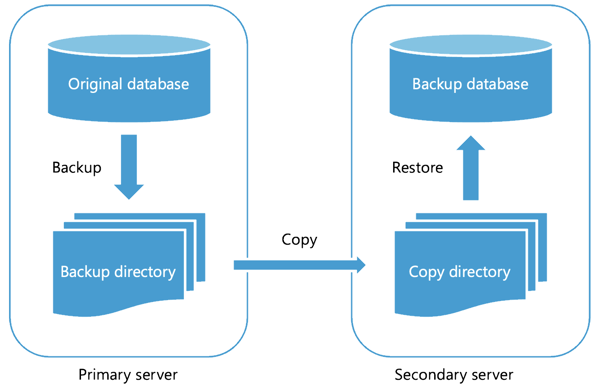Events
Take the Microsoft Learn AI Skills Challenge
Sep 24, 11 PM - Nov 1, 11 PM
Elevate your skills in Microsoft Fabric and earn a digital badge by November 1.
Register nowThis browser is no longer supported.
Upgrade to Microsoft Edge to take advantage of the latest features, security updates, and technical support.
Applies to:
SQL Server - Linux
Log shipping is a SQL Server high availability (HA) configuration where a database from a primary server is replicated onto one or more secondary servers. Log shipping allows backup files from the source database to restore onto the secondary server. The primary server creates transaction log backups periodically, and the secondary servers restore them, updating the secondary copy of the database.

As described in the previous diagram, a log shipping session involves the following steps:
Note
This tutorial uses CIFS + Samba to setup the network share.
Install Samba with the following command:
For Red Hat Enterprise Linux (RHEL):
sudo yum -y install samba
For Ubuntu:
sudo apt-get install samba
Create a directory to store the logs for log shipping, and give the mssql user the required permissions:
mkdir /var/opt/mssql/tlogs
chown mssql:mssql /var/opt/mssql/tlogs
chmod 0700 /var/opt/mssql/tlogs
Edit the /etc/samba/smb.conf file (you need root permissions), and add the following section:
[tlogs]
path=/var/opt/mssql/tlogs
available=yes
read only=yes
browsable=yes
public=yes
writable=no
Create a mssql user for Samba:
sudo smbpasswd -a mssql
Restart the Samba services:
sudo systemctl restart smbd.service nmbd.service
Install the CIFS client with the following command:
For RHEL:
sudo yum -y install cifs-utils
For Ubuntu:
sudo apt-get install cifs-utils
Create a file to store your credentials. In this example, we use /var/opt/mssql/.tlogcreds. Use the password you recently set for your mssql Samba account, and replace <domain>:
username=mssql
domain=<domain>
password=<password>
Run the following commands to create an empty directory for mounting and set permission and ownership correctly
mkdir /var/opt/mssql/tlogs
sudo chown root:root /var/opt/mssql/tlogs
sudo chmod 0550 /var/opt/mssql/tlogs
sudo chown root:root /var/opt/mssql/.tlogcreds
sudo chmod 0660 /var/opt/mssql/.tlogcreds
Add the line to etc/fstab to persist the share. Replace <ip_address_of_primary_server> with the appropriate value:
//<ip_address_of_primary_server>/tlogs /var/opt/mssql/tlogs cifs credentials=/var/opt/mssql/.tlogcreds,ro,uid=mssql,gid=mssql 0 0
Mount the shares:
sudo mount -a
Back up the database on the primary server:
BACKUP DATABASE SampleDB TO DISK = '/var/opt/mssql/tlogs/SampleDB.bak'
GO
Configure log shipping on the primary server:
DECLARE @LS_BackupJobId AS UNIQUEIDENTIFIER;
DECLARE @LS_PrimaryId AS UNIQUEIDENTIFIER;
DECLARE @SP_Add_RetCode AS INT;
EXECUTE @SP_Add_RetCode = master.dbo.sp_add_log_shipping_primary_database
@database = N'SampleDB',
@backup_directory = N'/var/opt/mssql/tlogs',
@backup_share = N'/var/opt/mssql/tlogs',
@backup_job_name = N'LSBackup_SampleDB',
@backup_retention_period = 4320,
@backup_compression = 2,
@backup_threshold = 60,
@threshold_alert_enabled = 1,
@history_retention_period = 5760,
@backup_job_id = @LS_BackupJobId OUTPUT,
@primary_id = @LS_PrimaryId OUTPUT,
@overwrite = 1;
IF (@@ERROR = 0 AND @SP_Add_RetCode = 0)
BEGIN
DECLARE @LS_BackUpScheduleUID AS UNIQUEIDENTIFIER;
DECLARE @LS_BackUpScheduleID AS INT;
EXECUTE msdb.dbo.sp_add_schedule
@schedule_name = N'LSBackupSchedule',
@enabled = 1,
@freq_type = 4,
@freq_interval = 1,
@freq_subday_type = 4,
@freq_subday_interval = 15,
@freq_recurrence_factor = 0,
@active_start_date = 20170418,
@active_end_date = 99991231,
@active_start_time = 0,
@active_end_time = 235900,
@schedule_uid = @LS_BackUpScheduleUID OUTPUT,
@schedule_id = @LS_BackUpScheduleID OUTPUT;
EXECUTE msdb.dbo.sp_attach_schedule
@job_id = @LS_BackupJobId,
@schedule_id = @LS_BackUpScheduleID;
EXECUTE msdb.dbo.sp_update_job @job_id = @LS_BackupJobId, @enabled = 1;
END
EXECUTE master.dbo.sp_add_log_shipping_alert_job;
EXECUTE master.dbo.sp_add_log_shipping_primary_secondary
@primary_database = N'SampleDB',
@secondary_server = N'<ip_address_of_secondary_server>',
@secondary_database = N'SampleDB',
@overwrite = 1;
Restore the database on the secondary server:
RESTORE DATABASE SampleDB
FROM DISK = '/var/opt/mssql/tlogs/SampleDB.bak'
WITH NORECOVERY;
Configure log shipping on the secondary server:
DECLARE @LS_Secondary__CopyJobId AS UNIQUEIDENTIFIER;
DECLARE @LS_Secondary__RestoreJobId AS UNIQUEIDENTIFIER;
DECLARE @LS_Secondary__SecondaryId AS UNIQUEIDENTIFIER;
DECLARE @LS_Add_RetCode AS INT;
EXECUTE @LS_Add_RetCode = master.dbo.sp_add_log_shipping_secondary_primary
@primary_server = N'<ip_address_of_primary_server>',
@primary_database = N'SampleDB',
@backup_source_directory = N'/var/opt/mssql/tlogs/',
@backup_destination_directory = N'/var/opt/mssql/tlogs/',
@copy_job_name = N'LSCopy_SampleDB',
@restore_job_name = N'LSRestore_SampleDB',
@file_retention_period = 4320,
@overwrite = 1,
@copy_job_id = @LS_Secondary__CopyJobId OUTPUT,
@restore_job_id = @LS_Secondary__RestoreJobId OUTPUT,
@secondary_id = @LS_Secondary__SecondaryId OUTPUT
IF (@@ERROR = 0 AND @LS_Add_RetCode = 0)
BEGIN
DECLARE @LS_SecondaryCopyJobScheduleUID AS UNIQUEIDENTIFIER;
DECLARE @LS_SecondaryCopyJobScheduleID AS INT;
EXECUTE msdb.dbo.sp_add_schedule
@schedule_name = N'DefaultCopyJobSchedule',
@enabled = 1,
@freq_type = 4,
@freq_interval = 1,
@freq_subday_type = 4,
@freq_subday_interval = 15,
@freq_recurrence_factor = 0,
@active_start_date = 20170418,
@active_end_date = 99991231,
@active_start_time = 0,
@active_end_time = 235900,
@schedule_uid = @LS_SecondaryCopyJobScheduleUID OUTPUT,
@schedule_id = @LS_SecondaryCopyJobScheduleID OUTPUT;
EXECUTE msdb.dbo.sp_attach_schedule
@job_id = @LS_Secondary__CopyJobId,
@schedule_id = @LS_SecondaryCopyJobScheduleID;
DECLARE @LS_SecondaryRestoreJobScheduleUID AS UNIQUEIDENTIFIER;
DECLARE @LS_SecondaryRestoreJobScheduleID AS INT;
EXECUTE msdb.dbo.sp_add_schedule
@schedule_name = N'DefaultRestoreJobSchedule',
@enabled = 1,
@freq_type = 4,
@freq_interval = 1,
@freq_subday_type = 4,
@freq_subday_interval = 15,
@freq_recurrence_factor = 0,
@active_start_date = 20170418,
@active_end_date = 99991231,
@active_start_time = 0,
@active_end_time = 235900,
@schedule_uid = @LS_SecondaryRestoreJobScheduleUID OUTPUT,
@schedule_id = @LS_SecondaryRestoreJobScheduleID OUTPUT;
EXECUTE msdb.dbo.sp_attach_schedule
@job_id = @LS_Secondary__RestoreJobId,
@schedule_id = @LS_SecondaryRestoreJobScheduleID;
END
DECLARE @LS_Add_RetCode2 AS INT;
IF (@@ERROR = 0 AND @LS_Add_RetCode = 0)
BEGIN
EXECUTE @LS_Add_RetCode2 = master.dbo.sp_add_log_shipping_secondary_database
@secondary_database = N'SampleDB',
@primary_server = N'<ip_address_of_primary_server>',
@primary_database = N'SampleDB',
@restore_delay = 0,
@restore_mode = 0,
@disconnect_users = 0,
@restore_threshold = 45,
@threshold_alert_enabled = 1,
@history_retention_period = 5760,
@overwrite = 1;
END
IF (@@ERROR = 0 AND @LS_Add_RetCode = 0)
BEGIN
EXECUTE msdb.dbo.sp_update_job
@job_id = @LS_Secondary__CopyJobId,
@enabled = 1;
EXECUTE msdb.dbo.sp_update_job
@job_id = @LS_Secondary__RestoreJobId,
@enabled = 1;
END
Verify that log shipping works by starting the following job on the primary server:
USE msdb;
GO
EXECUTE dbo.sp_start_job N'LSBackup_SampleDB';
GO
Verify that log shipping works by starting the following job on the secondary server:
USE msdb;
GO
EXECUTE dbo.sp_start_job N'LSCopy_SampleDB';
GO
EXECUTE dbo.sp_start_job N'LSRestore_SampleDB';
GO
Verify that log shipping failover works by executing the following command:
Warning
This command will bring the secondary database online and break the log shipping configuration. You need to reconfigure log shipping after running this command.
RESTORE DATABASE SampleDB WITH RECOVERY;
Events
Take the Microsoft Learn AI Skills Challenge
Sep 24, 11 PM - Nov 1, 11 PM
Elevate your skills in Microsoft Fabric and earn a digital badge by November 1.
Register nowTraining
Module
Deploy SQL Server on Linux - Training
Learn about prerequisites to run SQL Server on Linux and the steps to install SQL Server on Linux. Also, learn about installing command-line tools.
Certification
Microsoft Certified: Azure Database Administrator Associate - Certifications
Administer an SQL Server database infrastructure for cloud, on-premises and hybrid relational databases using the Microsoft PaaS relational database offerings.